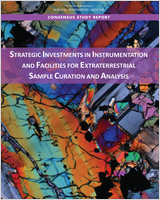NCBI Bookshelf. A service of the National Library of Medicine, National Institutes of Health.
National Academies of Sciences, Engineering, and Medicine; Division on Engineering and Physical Sciences; Space Studies Board; Committee on Extraterrestrial Sample Analysis Facilities. Strategic Investments in Instrumentation and Facilities for Extraterrestrial Sample Curation and Analysis. Washington (DC): National Academies Press (US); 2018 Dec 20.

Strategic Investments in Instrumentation and Facilities for Extraterrestrial Sample Curation and Analysis.
Show details1.1. BACKGROUND
To prepare for the analysis of diverse extraterrestrial samples in the coming decades, NASA requires information on the current capabilities of the planetary science community's analytical laboratory facilities, their future requirements, and any associated challenges. Therefore, the National Academies of Sciences, Engineering, and Medicine assembled a committee to determine what capabilities are required for curation and analyses of returned samples, whether such capabilities are currently accessible, and whether NASA's investment strategy provides the resources to meet these requirements and adequately prepares the scientific community to meet the challenges of future extraterrestrial sample analyses.
Sample return missions seek to marshal all of the technological and methodological sophistication of terrestrial laboratories for the study of extraterrestrial materials. Although there have been dramatic advances in, and successes of, remote sensing and robotic systems for sampling and analysis on planetary surfaces, it remains true that the most sophisticated remote and in situ observations of other planetary bodies return information that is sparse in its scope and orders of magnitude poorer in sensitivity, precision, accuracy, and spatial scale as compared to what is possible in laboratory studies. And, whereas in situ observations are made in a limited time frame using only those techniques that could be anticipated when a mission was designed, returned samples remain available for study by techniques invented years later.
Sample return missions present laboratories with four challenges that each call for unique infrastructure, resources, and skills (see more extended descriptions in Section 4.1):
- 1.
Recovery and initial curation: Initial curation begins through dialogue between the mission scientists and NASA Johnson Space Center curatorial staff during the creation of the mission proposal, as all sample return missions are required to have a curation plan. The tasks faced by Earth-bound laboratories begin with the acquisition of the samples and their transit back to Earth and then determining whether the samples have been changed in any way. Once the samples are back on Earth, the returned vessel must be located, reached, and observed to determine whether it survived intact or was breached. The vessel then must be returned to a controlled laboratory space, potentially contending with severe problems of contamination and planetary protection.
- 2.
Initial characterization and triaging: Returned samples must be observed by nondestructive and minimally destructive techniques to document their number, size, and material properties and to prioritize samples for analysis, guided by the science goals of the mission but responsive to any unanticipated discoveries.
- 3.
Characterization: After preliminary characterization at the curatorial facility, samples need to be analyzed by cutting-edge methods. Many of these analyses will involve transporting the samples off-site to analytical laboratories globally.
- 4.
Long-term curation: All returned samples require long-term curation in specially prepared laboratories that minimize terrestrial contamination while at the same time allowing samples to be accessed by laboratories around the world.
The four tasks outlined above have been faced by one ongoing and five prior programs of extraterrestrial sample return: the cosmic dust collection, the Apollo program, the Luna program, and the Genesis, Stardust, and Hayabusa missions. However, in the coming decades, sample return missions will have to address three substantial changes brought about by shifting scientific goals and a changing community of stakeholders in sample return missions:
- 1.
From rocks and minerals to gases, organic materials, and ices;
- 2.
Planetary protection; and
- 3.
Commercial partners and increased international collaboration.
1.2. COMMITTEE CHARGE AND SCOPE
According to its charge, the committee will assess the following:
- What laboratory analytical capabilities are required to support the NASA Planetary Science Division's (and partners') analysis and curation of existing and future extraterrestrial samples?
- Which of these capabilities currently exist, and where are they located (including international partner facilities)?
- What existing capabilities are not currently accessible that are/will be needed?
- Whether the current sample laboratory support infrastructure and NASA's investment strategy meet the analytical requirements in support of current and future decadal planetary missions.
- How can NASA ensure that the science community can stay abreast of evolving techniques and be at the forefront of sample analysis?
Currently, there are two sample return missions flying that will return samples from asteroids— Origins, Spectral Interpretation, Resource Identification, Security, Regolith Explorer (OSIRIS-REx) and Hayabusa2—and two mission concepts currently under consideration—Martian Moons Exploration and Comet Astrobiology Exploration Sample Return (see descriptions in Chapter 3). There are currently no missions in the planning stages that propose to return ices. This report therefore focuses especially on the current missions, although it also briefly looks to the future needs for return of gases, organic matter, and ices. Mars sample return is expected but is likely decades into the future, so issues related to martian sample return, such as planetary protection, are only briefly touched on here.
BOX 1.1
A Few Useful Definitions.
- Introduction - Strategic Investments in Instrumentation and Facilities for Extra...Introduction - Strategic Investments in Instrumentation and Facilities for Extraterrestrial Sample Curation and Analysis
- Homo sapiens stannin, mRNA (cDNA clone IMAGE:2819472), partial cdsHomo sapiens stannin, mRNA (cDNA clone IMAGE:2819472), partial cdsgi|33869653|gb|BC005837.2|Nucleotide
Your browsing activity is empty.
Activity recording is turned off.
See more...